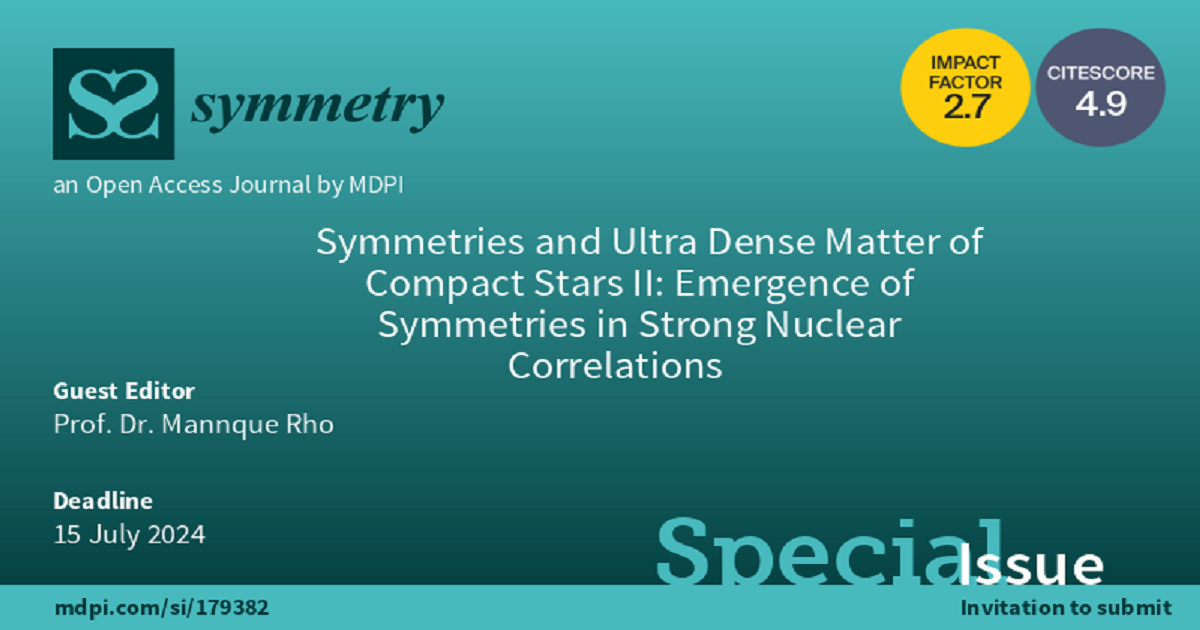Symmetries and Ultra Dense Matter of Compact Stars II: Emergence of Symmetries in Strong Nuclear Correlations
A special issue of Symmetry (ISSN 2073-8994). This special issue belongs to the section "Physics".
Deadline for manuscript submissions: 15 July 2024 | Viewed by 3266

Special Issue Editor
Interests: theoretical nuclear; hadron physics
Special Issues, Collections and Topics in MDPI journals
Special Issue Information
Dear Colleagues,
In going from dilute baryonic systems to super dense astrophysical systems on the verge of gravitational collapse, ranging from few-nucleon nuclei to infinite nuclear matter to superdense compact star matter, one moves, in pursuing the strong interaction QCD with its UV completion, from pionless effective theory with nucleons only to chiral effective field theory with nucleons and pions, until the latter breaks down at densities near (2–3) times the normal nuclear matter density n_0. The mass scale for the breakdown is of the lowest vector mesons \rho, \omega, and the dilaton with emergent local and global symmetries, respectively. At this scale, it is futile to bring in the microscopic degrees of freedom of QCD. This cross-over regime is, at present, more or less totally unknown. And this is the regime that this Special Issue will address. It will involve various hidden symmetries, some explicitly associated with the gauge theory QCD, but more likely emergent in the strong nuclear correlations involving the relevant degrees of freedom in the background of a sliding vacuum. What could be involved is listed in the key words. They promise to be rich in surprises, not always ensuing from the inherent symmetries of QCD proper, but possibly resembling what is taking place in condensed matter systems.
Prof. Dr. Mannque Rho
Guest Editor
Manuscript Submission Information
Manuscripts should be submitted online at www.mdpi.com by registering and logging in to this website. Once you are registered, click here to go to the submission form. Manuscripts can be submitted until the deadline. All submissions that pass pre-check are peer-reviewed. Accepted papers will be published continuously in the journal (as soon as accepted) and will be listed together on the special issue website. Research articles, review articles as well as short communications are invited. For planned papers, a title and short abstract (about 100 words) can be sent to the Editorial Office for announcement on this website.
Submitted manuscripts should not have been published previously, nor be under consideration for publication elsewhere (except conference proceedings papers). All manuscripts are thoroughly refereed through a single-blind peer-review process. A guide for authors and other relevant information for submission of manuscripts is available on the Instructions for Authors page. Symmetry is an international peer-reviewed open access monthly journal published by MDPI.
Please visit the Instructions for Authors page before submitting a manuscript. The Article Processing Charge (APC) for publication in this open access journal is 2400 CHF (Swiss Francs). Submitted papers should be well formatted and use good English. Authors may use MDPI's English editing service prior to publication or during author revisions.
Keywords
- super dense matter
- topology change
- hadron-quark continuity
- IR fixed point
- dilatons
- vector manifestation
- emergent hidden symmetries
- chiral-scale effective field theory
- generalized density-functional theory
- Landau–Migdal Fermi-liquid theory
- un-Fermi liquids





